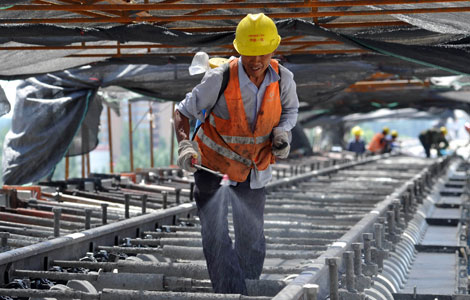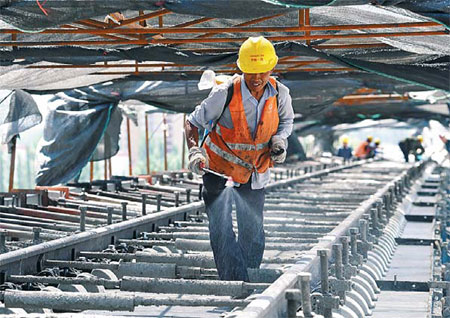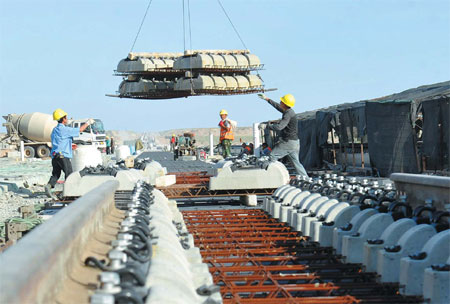Challenging times on 'high-speed Silk Road'
Updated: 2013-07-12 07:24
By Cui Jia (China Daily)
|
||||||||
|
Work proceeds on the Lanzhou-Urumqi high-speed railway, the longest such rail link under construction in the world. Yao Tong / for China Daily |
|
Workers unload parts for the ballastless track in Hami, part of the Lanzhou-Urumqi high-speed railway route. The project is scheduled for completion in 2014. Photos by Yao Tong / for China Daily |
|
Construction teams work at night to avoid the intense daytime heat that causes the water in the concrete mix to evaporate too rapidly. |
|
China's first windproof railway tunnel, in the Shisanjianfang district of Hami, where the winds are fierce and gales occur on more than 250 days of the year. |
Workers on new 1,776-km rail link no strangers to tough conditions, reports Cui Jia in Urumqi.
It was just after midnight in Hami prefecture in the Xinjiang Uygur autonomous region and the construction workers on the Lanzhou-Urumqi high-speed railway had just started work.
The men work at night to avoid the intense heat of the day that causes the water in the concrete mix to evaporate too quickly and could compromise the strength of the bridge being built, making it too fragile to meet stringent safety and engineering standards.
The stifling summer heat is just one of the challenges facing the 30,000 workers on the Xinjiang section of the project.
The 1,776-km-long railway, which on completion will link the capitals of Gansu province and Xinjiang, crosses the desolate and inhospitable Qinghai-Tibet Plateau, the arid sands of the Gobi Desert and a number of high-wind areas. These features make construction of the rail link a difficult and risky task.
The project, dubbed the "high-speed Silk Road", is the longest high-speed railway under construction in the world and the first in China to be built partly across a plateau.
After five years' work in Gansu, Xinjiang and Qinghai province, the line is scheduled to be operational by the end of 2014. The team in Xinjiang expects to finish laying the tracks by November.
Currently, only one railway carries passengers and cargo in and out of Xinjiang, the old Lanzhou-Urumqi railway, which connects Xinjiang with the rest of China and also provides a link to Central Asia and Europe.
The new line follows hot on the heels of the 11,179-km Chongqing-Xinjiang-Europe International Railway, which officially came into service in 2012. The C-X-E starts in Chongqing, crosses the Alataw Pass, on the border with Kazakhstan, via the old Lanzhou-Urumqi railway, and then progresses through Russia, Belarus and Poland before terminating at Duisburg, Germany. The journey takes an average of 16 days, roughly three weeks faster than the ocean route from China's eastern provinces.
Journey times slashed
More than 95 percent of Xinjiang's freight traffic is carried on the old Lanzhou-Urumqi railway. Meanwhile, the high cost of air travel means the railway is also the primary mode of travel for 90 percent of passengers traveling in and around the autonomous region. However, the strain imposed on the local travel network means logistics costs are high, a factor that has limited the pace of the region's development, according to the Urumqi Railway Bureau, which is overseeing the construction and management of the new high-speed railway.
With a designed speed of 250 km per hour, the Lanzhou-Urumqi high-speed railway will provide a faster and more convenient route between the provincial and regional capitals. When the railway is finished, the journey time between the cities will be cut by half - from around 20 hours to less than 10. The high-speed railway will carry all passenger traffic, while the old Lanzhou-Urumqi railway will be used for freight only.
The bureau said construction of a railway to connect Hami prefecture with the Inner Mongolia autonomous region may begin by the end of the year, forging another link between Xinjiang and China's inland regions. Meanwhile, a railway linking southern Xinjiang's Hotan and Xigaze in the Tibet autonomous region is also under consideration.
Wind zones
In Xinjiang, strong winds are a major threat to the safety of the high-speed railway, according to Ma Xizhang of the project management department of Xinjiang Lanzhou-Urumqi Railway Co, which is responsible for construction of a 710-km stretch of railway in Xinjiang.
The high-speed railway will pass through three of the region's most-feared areas, where winds traveling at speeds of up to 166 km per hour regularly disrupt operations on the old Lanzhou-Urumqi railway and have even been known to overturn trains.
"The nature of the high-speed railway means the threat posed by the wind is much higher than for a conventional railway, so windproofing projects are crucial to its success," said Ma.
Earlier this week, China's first windproof railway tunnel was completed in the Shisanjianfang district of Hami, where the winds are strongest and gales occur on more than 250 days of the year.
Without citing a specific figure, Ma said the construction costs were high but the 1-km-long tunnel is essential. "When the company's inspection team arrived in the area in 2010, the windows in their cars were smashed by stones carried on the sudden, strong winds. If that happened to a high-speed train, it would be a disaster."
More than 65 percent of the Lanzhou-Urumqi high-speed railway in Xinjiang will cross these wind zones. In addition to the tunnels, windbreaks are also being erected to further ensure the safety of the trains. The scale of windproofing is the largest of all the high-speed railways currently under construction in China.
Ancient artifacts
When the railway passes through Turpan prefecture it faces another challenge; a series of subterranean wells and irrigation channels called keraz, which date back to the Han Dynasties (206 BC-AD 220). There are thought to be around 1,600 keraz in the area around Turpan. They were built to prevent water evaporation in one of China's hottest areas and many are still in use.
Although the high-speed railway will only cross 14 keraz on its journey, all were reinforced before construction work began and bridges have been built to carry the engines and rolling stock over the ancient artifacts.
New hubs, purpose-built for high-speed trains, are also under construction. In addition to those in Urumqi and Hami city, stations are also being built in Turpan's Shanshan county and in Turpan city. Unlike the hubs on the old railway, the new stations will be located close to population centers to ensure ease of access. By 2020, Xinjiang will have four rail gateways to inland China, plus four circular lines to connect all the major cities in the region.
New links
Local people are also enthusiastic about plans to build a railway to connect Kashgar in Xinjiang with the Pakistani port of Gwadar.
In June, Pakistani Prime Minister Nawaz Sharif said Pakistan would like to build new road and rail links to Kashgar and establish a Sino-Pakistani economic corridor. In February, China Overseas Port Holding Co took over the management of Gwadar, a deep-water port on the shores of the Arabian Sea and situated close to the Strait of Hormuz and the Iranian border.
If an overland link were to be established, Gwadar Port would become the starting point for deliveries of oil and natural gas to Xinjiang.
"We've already been asked to carry out research into the location of a station at Kashgar for the China-Pakistan railway, but a detailed plan and timetable have yet to be drafted," said Wang Yongzhi, deputy commissioner of Kashgar prefecture, in June.
Wang said China's long experience of construction work on plateaus could prove invaluable if the decision is made to build a railway across the Pamir Plateau.
Yuan Jianmin, director of Xinjiang logistic association, said most freight from Pakistan is transported to China via the sea route, a journey of more than a month, whereas a railway link would allow goods to be transported from Pakistan to cities around China in roughly 10 days.
The poor condition of the roads between Kashgar and Pakistan means the network is ineffective, constraining exports to Pakistan via the land port at Kashgar to just 100,000 metric tons each year, according to Wang. "A railway link between China and Pakistan railway would transform Kashgar and allow it to truly become an economic hub," he said.
Contact the writer at cuijia@chinadaily.com.cn

(China Daily USA 07/12/2013 page5)
Most Viewed
Editor's Picks

|

|

|

|

|

|
Today's Top News
Saudi princess charged with US human trafficking
Asiana takes out apology ad in Chinese media
Asia spending too little on poor: report
Constructive mood at Sino-US talks
China, Russia consider increasing naval drills
No mechanical trouble on Asiana
More Americans favor immigration
Increased cooperation brings benefits
US Weekly

|

|


















